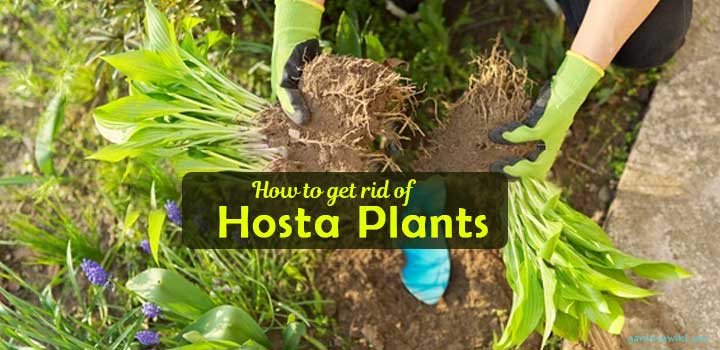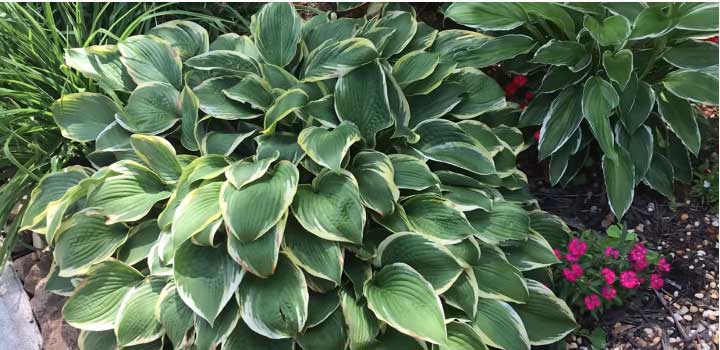Hosta plants are herbaceous perennials and are widely known for plants’ foliage instead of their leaves and flowers. But hostas can be affected by diseases easily that can affect other plants in the ground. Plus, a few pet animals are poisonous to these plants. Therefore, you may need to remove them.
But how to get rid of hosta plants and kill them permanently? Getting rid of these plants isn’t that difficult, but killing them for good can be time-consuming and tricky. You need a shovel and a killer solution for the process.

In the following discussion, we’ll provide you with why you may need to remove these plants and the process of getting rid of hostas.
Reasons Why You Should Remove Hosta Plants
Before you learn how to get rid of hosta plants, you should know exactly why you should remove these plants. Here are two reasons and times when you should remove hostas from your garden.
1. When You Have Pet Animals
Animals are attracted to hosta plants. But hosta plants contain toxic saponins, which are harmful to a few animals; again, few animals can still eat and digest hosta effectively.
For example, if you have pet rabbits, squirrels, deers, snails, and slugs, you can plant and grow hostas in your backyard and garden without any fear as their snacks.
But if you have pet cats, dogs, or horses, you shouldn’t plant hosta and if you ever see these plants, remove them as soon as possible.
When these animals eat hostas, it can cause diarrhea, depression, or vomiting. In that case, you should contact a professional veterinarian immediately.
2. When Hostas Have Diseases
One of the common diseases of hosta plants is Anthracnose. This disease is a kind of fungal disease that produces in both warm and mist weather.
If you see any large and irregular spot around the dark border, it can be a sign of this particular disease, however, don’t mix this sign with hosta pest.
To prevent nematode, you shouldn’t overwater the plants and maintain distance between the plants. You can also use a fungicide that is generally manufactured for this disease, or else you can remove all the existing hosta plants and plant them again.
Sclerotium bright is another fungus disease for hostas. This fungus first affects the lower leaves of the tree and gradually spreads onto the upper leaves. It causes leaves to turn wilted and brown.
This disease is relatively challenging to control from spreading and eventually can lead to root rot. Therefore, getting rid of the affected hostas can be an easy and quick solution for you.
Note: If you think of transplanting the healthy hostas from the affected ones, you must know if a hosta can survive out of the ground or not.
How To Get Rid of Overgrown Hostas?

Here’re some steps that you can follow to eliminate the overgrown hostas. Let’s check them out.
- Shovel up your hostas entirely. Hostas have shallow root systems, generally 1 foot deep, however, dig deeper and 1 foot around the plants to ensure all roots are removed.
- In most cases, only one application of any form of herbicide can quickly destroy the hosta.
- Create a mud basin around the hosta’s base and water it often for one to two days. The plant dies when the leaves turn yellow. This procedure requires a lot of time and work, and the plant may reappear. So be careful!
- Spray the hostas with boiling or very hot water. Hot water will scorch the leaves and destroy the plant.
Chemical Control of Hostas
- Water your hosta plants straight for a few days, then apply herbicides. And if it has rained recently, you may don’t need to wait longer before applying herbicide.
- Generally, herbicide works most effectively when the plants are actively growing, and the temperature is under 90° F. Just like fertilizer for hostas useful to grow them healthy, herbicides are useful to kill them.
- Use glyphosate, which is a nonselective herbicide. Spray the liquid solution directly over the leaves of the hosta so that foliage gets covered evenly, ensure that you don’t drip the liquid from the leaves.
Non-Chemical Hosta Control
- The process of removing hostas is easy when the soil is soft. If it hasn’t rained lately, water around the soil for two days straight deeply to make the soil soft.
- Once you’re done watering the plants, plow the entire hosta plant’s clump, including the root mass. To remove the root mass, you should dig up a foot to extend and beyond the perimeter of the clump. Repeat this process to remove the root mass from each plant.
- After removing the hostas, make sure you dispose of these plants somewhere in a manner so that the roots can’t establish and grow them back again in your yard. To prevent them from growing back, leave the plants under sunlight for a few days to kill them permanently.
- If you see any roots re-sprouting, dig them again or cut or pull out the roots from the ground.
Indeed killing hostas takes longer; cutting them instead of digging up is a better option. It’s because cutting them doesn’t kill the other vegetation that you may have planted after the first digging.
FAQs
Can I permanently kill hosta plants?
Killing the hostas permanently will take a longer time. But you can prevent new hostas from sprouting by digging them up when they emerge. Keep digging until you the last length of root and pick them out from the ground. Then leave them under sunlight until hostas are completely dead.
How deep is the root length of the hostas plants?
Generally, hostas roots can go deep under the soil up to 18 inches if the plant is large. When you take out the plant from the soil, transplant it in a tarp. It’ll protect your other plants or lawn from getting drenched by the soil falling from roots.
Can I kill hostas with vinegar?
Yes, vinegar can kill hosta plants. You can also use vinegar to remove weeds from the ground.
Conclusion
So now you know how to get rid of hosta plants using chemical and non-chemical ways. Non-chemical ways are best for killing hostas through it may need you to work harder than the removing ways with chemicals.
On the other hand, although chemical solutions are quick and effective, they can destroy other weeds or vegetation that you have planted on your lawn. In case you don’t have any problem with killing other weeds, you can go for the chemical control of hostas.